Does Plant Growth Regulator Use Impact Boll Size and Locule Number in Cotton?
February 24, 2025
Click on a tab below to see data collected each year for this study
TRIAL OBJECTIVE
- Over the last several seasons, the Bayer Crop Science Learning Center at Scott, Mississippi has evaluated the impacts of plant growth regulators (PGR), plant spacing, seeding rate, and variety selection on boll size, development, and locule number.
- Data have repeatedly indicated boll locule number to be influenced by many of the above factors.
- Bolls with five locules have been shown to have higher seed cotton weight, lint weight, and seed numbers than four-locule bolls.
- During 2024, the staff at the Bayer Crop Science Learning Center at Scott, MS positionally mapped six cotton varieties to document yield accumulation, locule numbers, and other important characteristics associated with cotton bolls.
- Axillary fruiting, often referred to as “back fruiting”, was also measured through plant mapping. Questions remain about potential indications that axillary fruiting contributes to modern cotton production systems.
- These data may contribute to explaining the effects that plant growth regulator use has in cotton and the compensatory ability of cotton plants from changes in boll size and/or weight.
RESEARCH SITE DETAILS

There were six Deltapine® brand cotton varieties planted in this trial:
- DP 2317 B3TXF
- DP 2537 B3TXF (NEW, Class of ’25)
- DP 2333 B3XF
- DP 2328 B3TXF
- DP 2127 B3XF
- DP 2038 B3XF
Plant growth regulator treatments included:
- Untreated control (UTC)
- Aggressive (AGG) PGR management with 4.2% mepiquat applied at the following timing:
- 6/21/2024: 16 fl oz/acre
- 7/3/2024: 16 fl oz/acre
- 7/17/2024: 16 fl oz/acre
Data were collected as follows:
Positional Mapping
- The Boll-O-Meter was used to document the fruiting profile and accumulation in each cotton variety by PGR application combination.
- Ten row feet per plot were mapped using the Learning Center standard protocol.
- Data were assimilated post-mapping for analysis.
- Seed cotton samples were weighed, ginned, and delinted into cohorts for each locule treatment. After mapping each variety/PGR combination, bolls were bulked as follows into the following cohorts:
- 4 Locule Bolls
- 5 Locule Bolls
- Turnout, seed numbers, and other parameters were derived from these samples by locule number cohort.
- Many parameters associated with fruiting pattern in cotton plants were obtained from this data.
Trial Design/Analysis
- Single replicate strip plot, and variety held as replication where appropriate for analysis.
- For analysis:
- Variety was held as replicate (n = 6) and PGR Treatment as main effect (n = 2).
- This analysis method may underestimate potential varietal interactions but does provide a sound basis for preliminary evaluation of effects and directions for future study.
- Standard Least Square Mean ANOVA performed via JMP to establish statistical differences or lack thereof. LSDs not calculated since the trial had only two treatments.
- Four and five locule comparisons (seed, weight, and fiber properties) were made using Student’s t-test and reported significantly different at p < 0.05.
- Axillary fruiting data presented as raw means.
UNDERSTANDING THE RESULTS
Gross Crop Effects: This section discusses the general effect on crop morphology, boll number, and fruit/yield accumulation. The potential interaction with varietal background should be noted here as some of the sampled varieties did not need intensive PGR application to optimize their yield potential. Thereby, some of the parameter effects are not significant but are included for full transparency.
- Final Plant Height (inches) – Plant height was not significantly reduced by aggressive PGR use in this trial. Several of the varieties were not extremely growthy in this trial. Some varieties needed more aggressive treatment later in the season than was applied. This may have contributed to a height effect from PGR use that was not significant.
- AGG = 40.92 inches
- UTC = 47.99 inches
- p = 0.1511
- Final Node Number – Total node number was not changed by PGR application.
- AGG = 22.10
- UTC = 21.99
- p = 0.9000
- Total Harvestable Bolls per Acre – Significantly greater numbers of harvestable bolls were present in aggressively managed plots.
- AGG = 330,096
- UTC = 276,685
- p = 0.0396
- Number of 4 Locule Harvestable Bolls per acre – Similar numbers of harvestable 4 locule bolls were present in the PGR treatments.
- AGG = 284249
- UTC = 268662
- p = 0.3658
- Number of 5 Locule Harvestable Bolls per acre – PGR use significantly increased (91%) the number of harvestable bolls with 5 locules across the trial.
- AGG = 79,429
- UTC = 41,606
- p = 0.0098
- Seed Cotton Yield (lb/acre) – Seed cotton yield was significantly increased by the aggressive use of PGR.
- AGG = 2,938
- UTC = 2,281
- p = 0.0267
- Lint Yield (lb/acre) – Lint yield was not significantly increased by the use of PGR in this trial. This lack of significance can likely be attributed to the interaction of variety (some varieties didn’t need aggressive management and some didn’t respond or responded negatively) along with some slight interaction with sample size – i.e. smaller samples. This is also at the very edge of significance – 0.08 vs. 0.05.
- AGG = 1,177
- UTC = 965
- p = 0.0835
- 4 Locule Seed Cotton Yield (lb/acre) – Aggressive PGR use did not significantly increase the contribution of 4 locule bolls to seed cotton yield.
- AGG = 2,191
- UTC = 1,927
- p = 0.1993
- 4 Locule Lint Yield (lb/acre) – Aggressive PGR use did not significantly increase the contribution of 4 locule bolls to lint yield.
- AGG = 880
- UTC = 812
- p = 0.4338
- 5 Locule Seed Cotton Yield (lb/per acre) – Aggressive PGR use significantly increased the contribution of 5 locule bolls to seed cotton yield. (A 111% increase, more than double).
- AGG = 747
- UTC = 354
- p = 0.0106
- 5 Locule Lint Yield (lb/per acre) – Aggressive PGR use significantly increased the contribution of 5 locule bolls to lint yield. (A 94% increase, almost double.).
- AGG = 297
- UTC = 153
- p = 0.0070
- These data implies that the increases in yield from PGR use in the tested varieties are due to changes in multiple yield components. Reallocation of energy from vegetative development to reproductive growth is very important when optimizing the potential of new and existing cotton varieties. Considerations would include:
- Increases in fruit retention and the corresponding total harvested boll number.
- Increases in the percentage of 5 locule bolls, which contribute disproportionally to yield.
- Increases in harvested axillary fruiting positions in some varieties.
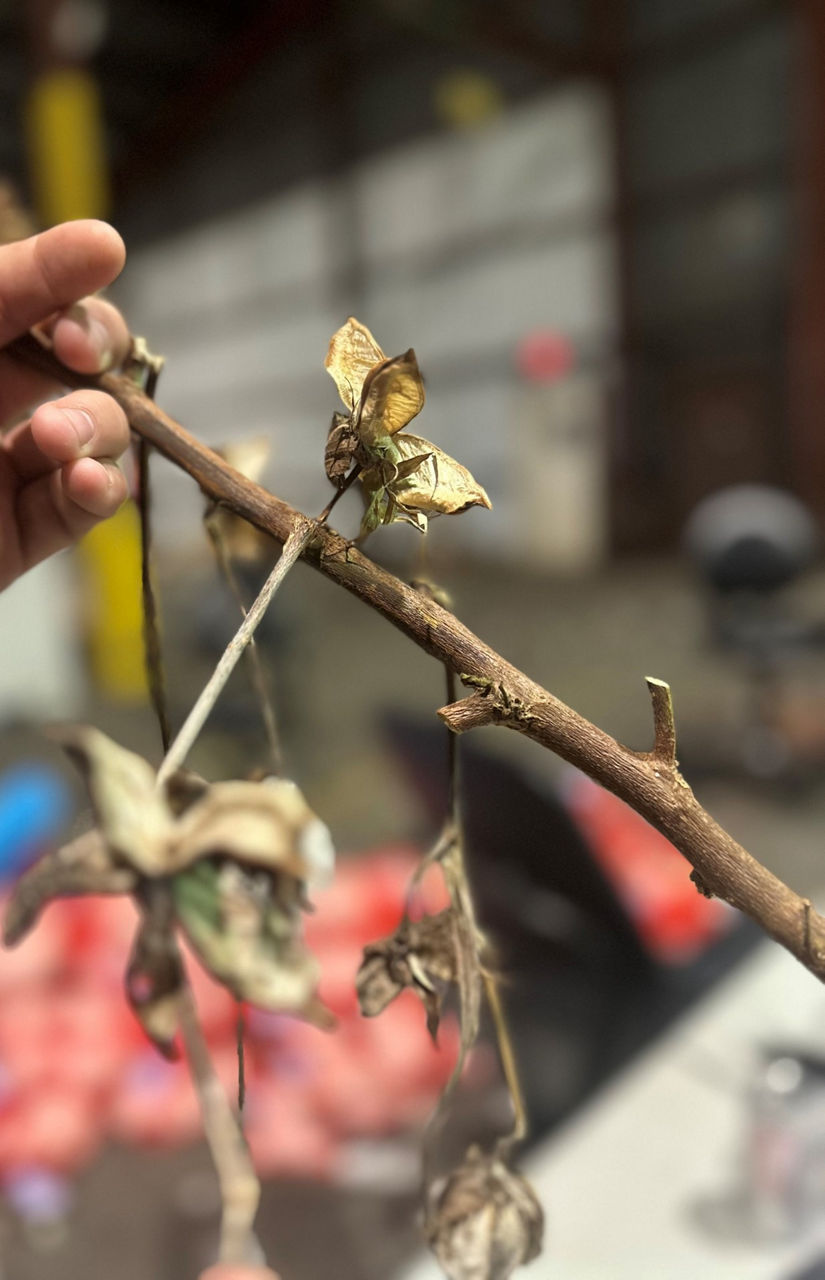
Bolls Positionally Mapped for this Study Across all Treatments and Fruit Types:
- 2,674 total bolls mapped
- 4 locule = 2,014/76.7%
- 5 locule = 633/23.3%
- 24 axillary bolls collected from the entire set of samples
- Commentary about axillary bolls:
- Axillary boll production (or “backfruiting”) has long been questioned in cotton production as to what it indicates for the cropping status. These data may help provide some insight into that question.
- The UTC treatments generated axillary fruit at the magnitude of 432 bolls per acre. This contributed approximately 1.4 lb lint/acre of yield to the entire crop when averaged across varieties, resulting in a minimal contribution.
- The aggressively managed treatments generated 6,189 axillary bolls per acre (14.3× the number from UTC plots) contributing approximately 23 lb lint/acre to the crop. This is a significant increase in the axillary contribution to yield; (p = 0.0175).
- The individual variety component of this interaction should be noted.
- Actual means (not LSMEANS) are reported here due to limitations in the data, i.e. it contained a large number of zeros.
- The axillary boll contributions were minimal in UTC plots.
- The axillary contribution to harvestable boll numbers in the aggressively managed plots ranged from 1,375 to 13,754 bolls per acre.
- The aggressively managed DP 2537 B3TXF and DP 2328 B3TXF generated 8,252 and 13,754 axillary bolls per acre respectively, which were the greatest contributions from the tested varieties.
- The axillary contribution to yield ranged from 3.8 to 59.1 lb lint/acre from axillary bolls in the aggressively managed plots.
- Preliminary Conclusions
- Axillary fruiting is heavily influenced by varietal background, energy status of the plant, and the associated interaction.
- PGR use appears to increase the contribution of axillary fruiting to the total crop productivity.
- While visually appealing, the presence of axillary fruit does seem to be a better indicator of energy status than a direct contributor to yield in most cases.
- Initial interpretation of the data would say in some (maybe all) varieties, PGR may help reallocate energy several ways around the cotton plant. One of those reallocations is potentially into axillary fruit by using excess plant energy to break axillary buds and develop fruit. This is primarily because growth has been limited by PGR use, current fruit load carbohydrate demand has been met, and the energy produced has nowhere else to go, so the energy is used to produce axillary fruit.
- Axillary fruit is not a major contributor to total yield, but it is a contributor none the less. Presence of axillary fruit should likely be viewed as a varietal trait and as an almost direct indicator of energy status in the plant. A well-managed cotton plant typically produces more axillary fruit compared to a poorly managed plant. This realization is an important result from this type of controlled experimenttrial. Growers rarely (practically never) have an untreated field to compare; there is a comparison at the Bayer Crop Science Learning Center at Scott, MS and, as a result, this trial can contribute to answering a key question– Do axillary bolls matter?
- Commentary about axillary bolls:
Boll Size – Bulk estimations across both 4 and 5 locule types; this is across all bolls on the plants – both sympodial and monopodial types. Variety was held as replicate (n = 6) and PGR Treatment as main effect (n = 2). LSDs were not calculated since the trial had only 2 treatments.
- Seed Cotton per Boll: Aggressive PGR use generated significantly heavier (9.3%) bolls across both boll types.
- AGG = 3.63 grams seed cotton/boll
- UTC = 3.32 grams seed cotton/boll
- p = 0.0297
- Lint per Boll: Aggressive PGR use generated similar lint weights per boll as the UTC. This may be attributed to the small sample size used in the ginning process. In studies during previous years, bolls have been heavier in both seed cotton and lint weight. In either case, bolls were not smaller where PGR was used aggressively.
- AGG = 1.44 grams lint cotton/boll
- UTC = 1.42 grams lint cotton/boll
- p = 0.6618
- PGR Influences on Locule Number: All bolls on the plant (monopodial and sympodial) were compared in these analyses.
- Across both Monopodial and Sympodial Bolls
- Percent of 5 Locule Bolls – The percentage of bolls present with 5 locules was increased by approximately 8% where aggressive PGR treatments were applied.
- AGG = 21.80%
- UTC = 13.60%
- p = 0.0080
- 5 locule contribution to total harvested weight – The corresponding contribution from 5 locule bolls to the total percentage of harvested yield was approximately 8% greater where aggressive PGR was applied vs UTC plots.
- AGG = 24.93%
- UTC = 16.68%
- p = 0.0153
- The differential contribution from 5 locule bolls was similar across both UTC and aggressively managed plots – approximately 3%. This implies that 5 locule bolls, when present in cotton crops, contribute disproportionally more to yield potential.
- Percent of 5 Locule Bolls – The percentage of bolls present with 5 locules was increased by approximately 8% where aggressive PGR treatments were applied.
- Across both Monopodial and Sympodial Bolls
- Locule number observations on lint percent, boll weight, and seed parameters. A non-paired, two-tailed t-test (p < 0.05) was used to compare the populations of boll types across the entire trial.
- Lint Percent – 24 total observations; n = 12 per boll type
- 4 Locule = 42.67%
- 5 Locule = 42.12%
- Prob>│t│ = 0.4769
- 4 and 5 locule bolls demonstrated statistically similar lint turnout.
- Seed Cotton per boll (grams) – 24 total observations; n = 12 per boll type
- 4 Locule = 3.60 grams/boll
- 5 Locule = 4.51 grams/boll
- Prob>│t│ = < 0.0001
- Bolls with 5 locules weighed significantly more (25.3% more) than 4 locule bolls.
- Lint per Boll (grams) – 24 total observations; n = 12 per boll type
- 4 Locule = 1.54 grams/boll
- 5 Locule = 1.90 grams/boll
- Prob>│t│ = <0.0001
- Bolls with 5 locules produce significantly more lint (23.4% more) than 4 locule bolls.
- Delinted seeds per boll – 24 total observations; n = 12 per boll type
- 4 Locule = 21.82 seeds/boll
- 5 Locule = 28.03 seeds/boll
- Prob>│t│ = <0.0001
- 5 locule bolls produce significantly greater (28.5% more) numbers of seed per boll.
- Delinted seeds per locule – 24 total observations; n = 12 per boll type
- 4 Locule = 5.46 seeds/locule
- 5 Locule = 5.61 seeds/locule
- Prob>│t│ = 0.3706
- 4 locule and 5 locule bolls contained a statistically similar number of seeds produced per locule.
- Lint Percent – 24 total observations; n = 12 per boll type
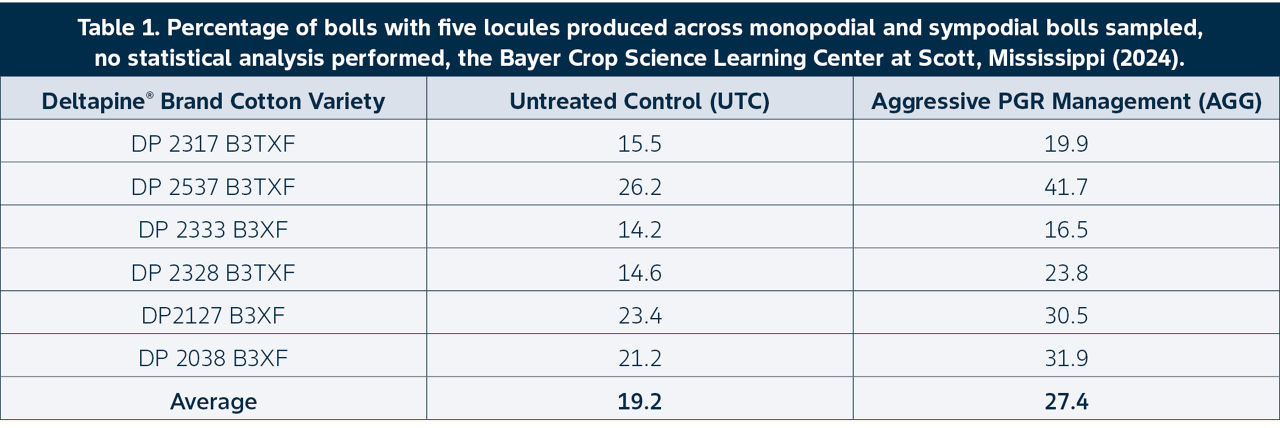
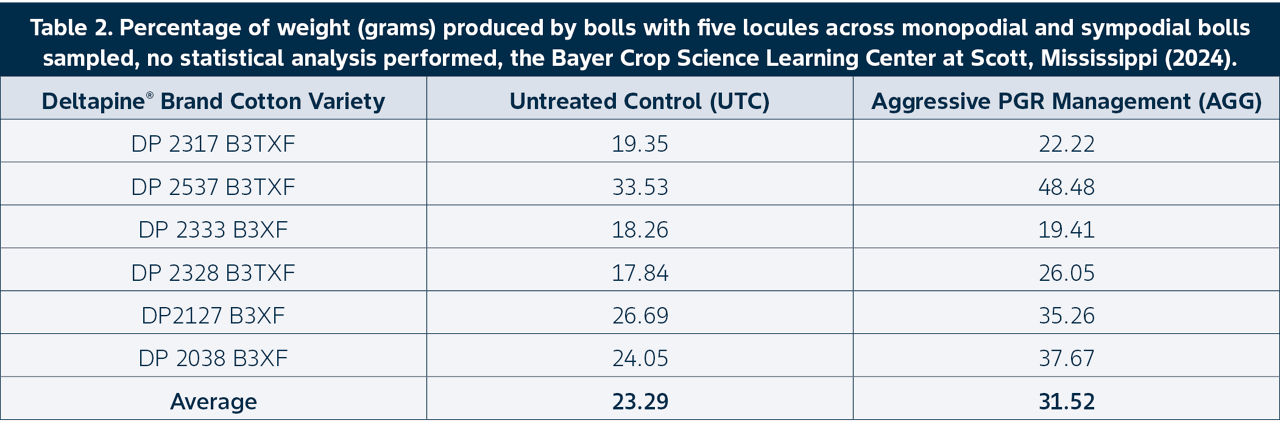
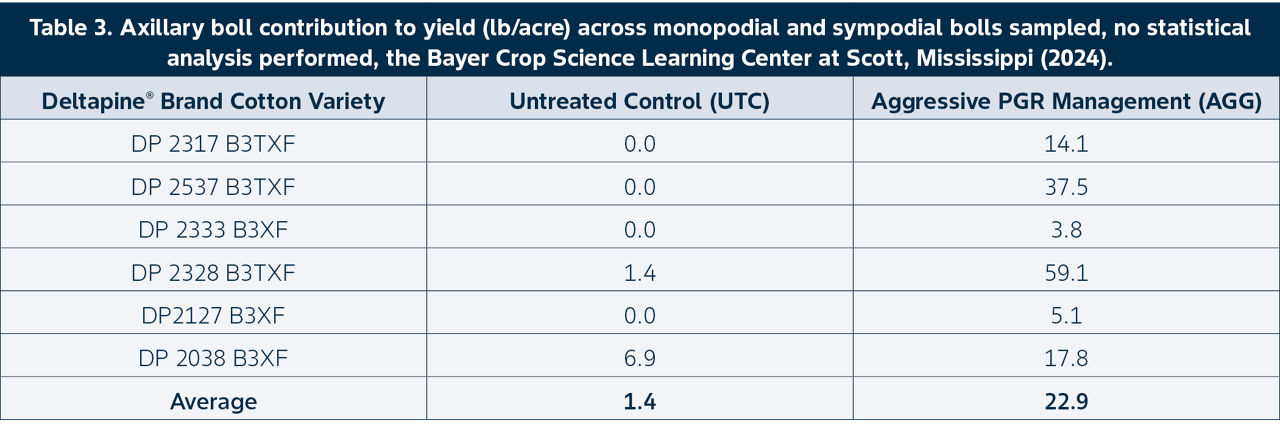
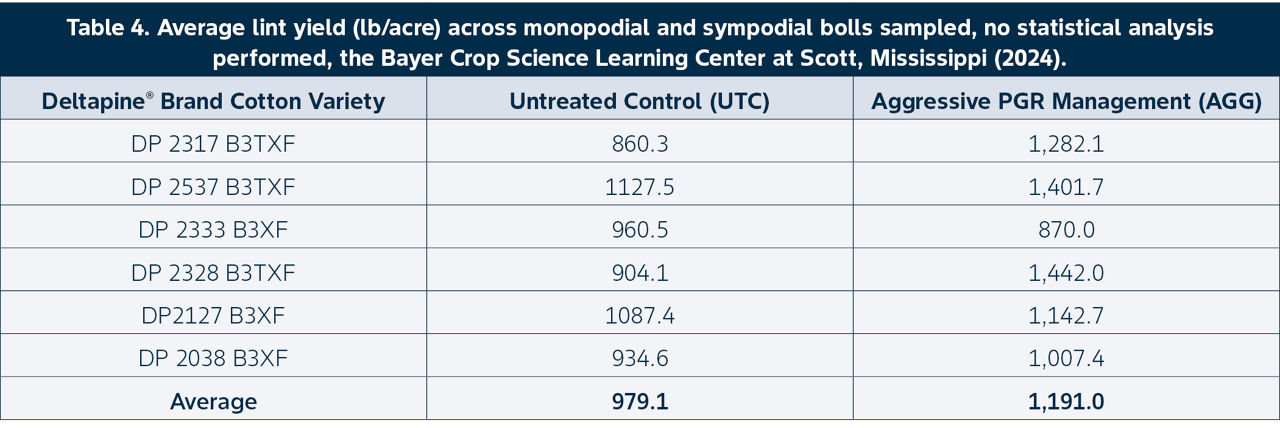
KEY LEARNINGS
- When considering both boll types as one population, aggressive PGR use generated significantly heavier bolls in seed cotton weight and similar lint weight per boll.
- Aggressive PGR use increased the percentage of bolls with five locules significantly, by about 8% with a range of 1.2 to 15.0% depending on variety.
- Across this study, five locule bolls contributed disproportionally to the yield of mapped plants (3 to 4% more). This was true in both aggressively managed (AGG) and untreated control (UTC) treatments.
- Five-locule bolls produced significantly more delinted seeds per boll than four-locule bolls.
- Both four- and five-locule bolls produced a similar number of delinted seeds per locule.
- Both four- and five-locule bolls produced fiber of similar lint turnout percentage.
- In this study, cotton varieties responded differently to PGR use across many parameters. Locule number determination was no different, in that some varieties inherently produced more five-locule bolls and some reacted differentially to the PGRs.
- Axillary fruiting significantly increased in plots where aggressive PGR treatments were applied. This reaction has an interaction with varietal background that should be carefully considered in future evaluations.
- Population, plant-to-plant spacing, variety, and now PGR use has been demonstrated to produce more five-locule bolls.
- This should be viewed not as a management technique but as an explanation of long-standing observations from many cotton production environments.
- Please contact your local Deltapine® representative for more information.
1414_347700